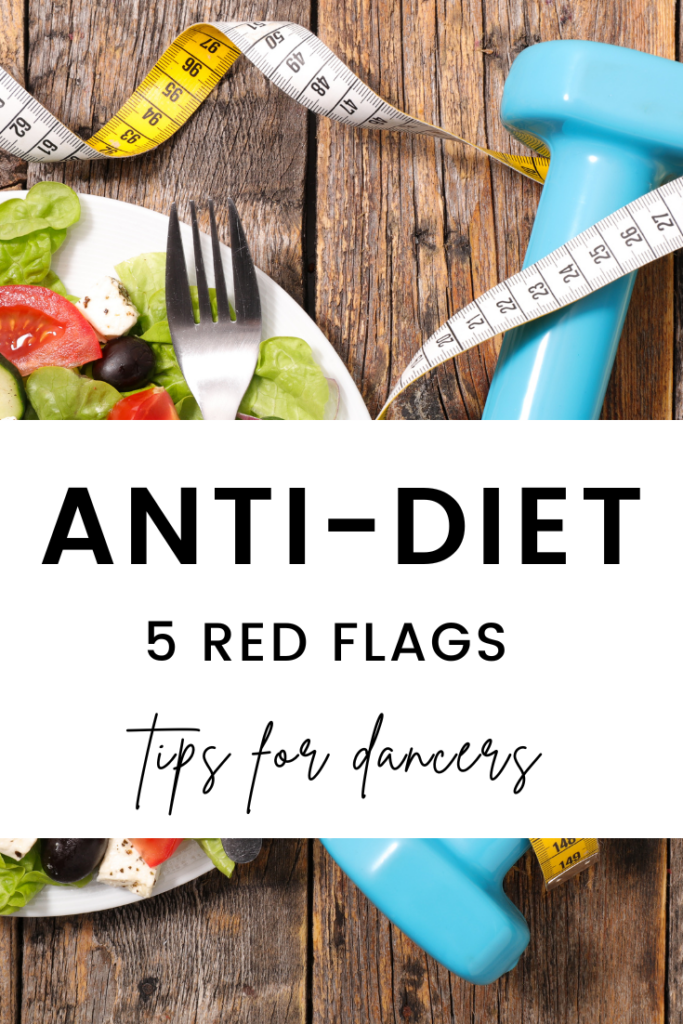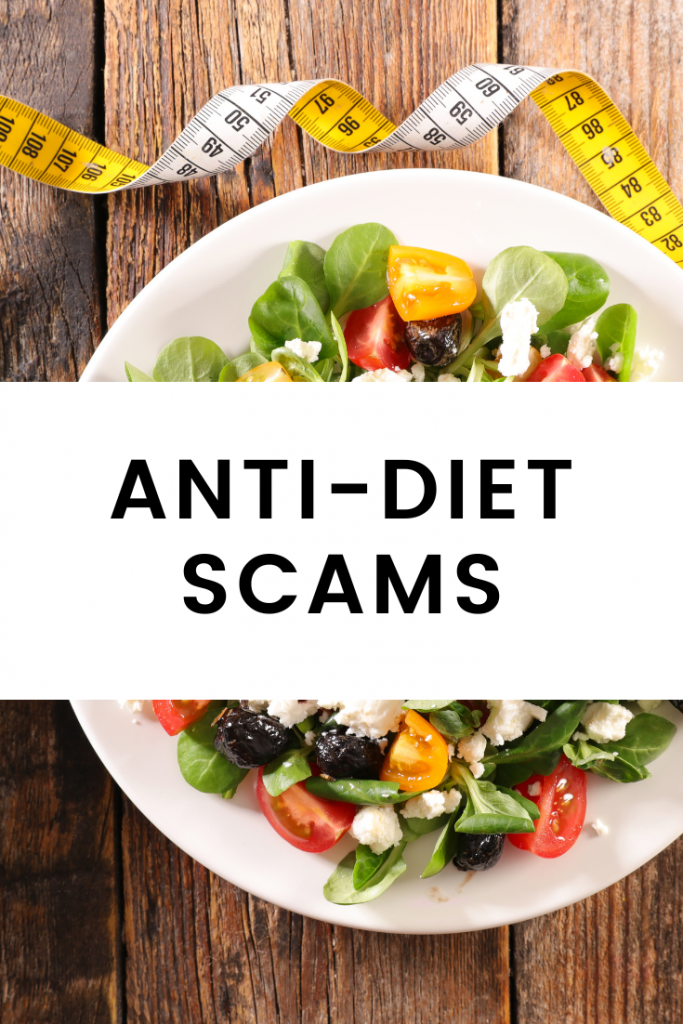Large corporations thrive on major earnings, and the fleeting results of weight loss dieting are a proven source of that. But an interesting shift is changing the dieting industry. Growing consumer demand to swap dieting with more wholesome approaches means that companies are coercing terms like “anti-diet,” “food freedom,” “holistic nutrition,” and “wellness” to guise restrictive plans. The bottom line: more than ever, “anti”-diet culture is selling, too.
Just because something says it’s anti-diet doesn’t mean it actually is.
Here are 5 red flags to help you spot when a program, coach, or influencer promotes diet culture— even if it’s wrapped in anti-diet language.
🚩 Red Flag #1: It Offers a “Better Way” to Lose Weight
Even if weight loss isn’t the main promise, if a program promotes weight loss as a guaranteed outcome of healing your relationship with food, it’s still a diet. You might see tons of before-and-after photos, or language like:
- “Weight loss without restriction.”
- “Eat more intuitively to drop pounds effortlessly.”
- “Ditch diets and still shrink your waist.”
The same goes for body composition changes like increased muscularity and decreased fat mass, both emphasized in the dance world.
Why it’s a problem: Real intuitive eating doesn’t guarantee weight loss— and that’s the point. Your body will settle at its natural weight (your set point) when it’s consistently nourished. Promising weight loss suggests that the primary goal is still control, and the reality is that most people cannot sustain weight loss after extreme dieting. Here are a few more facts to keep in mind:
- Weight cycling (as defined by repeatedly losing and gaining weight) is associated with long-term weight gain.
- Weight cycling is also an independent risk factor for heart disease.
- Weight stigma (such as the discrimination a dancer might experience at auditions) is associated with negative health outcomes.
- Behaviors that support long-term (AKA “successful”) weight loss most parallel behaviors seen in anorexia nervosa.
- Dancers have a three times higher risk of suffering from eating disorders than the general population.
- Eating disorders have the second highest mortality rate of any mental health disorders.
A real anti-diet approach emphasizes body trust and nourishment, not manipulating your diet to change your size. For dancers, even if weight loss is suggested by those “higher up,” it’s important to consider the sacrifices (physical, mental, and emotional health) when pursuing the path of dieting.
🚩 Red Flag #2: There Are “Good” and “Bad” Food Swaps
Brush up on your knowledge about the dieting mentality and look out for moralizing language like “clean,” “junk,” or “guilt-free.” It might sound like:
- Suggestions to “avoid” or “limit” any food or food group (common examples are “processed foods,” “refined grains,” “dairy,” and “refined sugar.”
- “It’s not a diet, it’s a lifestyle change.”
- “Cleanse your fridge.”
- “Crowd-out sweets by eating only whole and minimally processed foods.”
- “Detox from your weekend.”
- “Stick to whole foods, mostly plants.”
- “X foods are bad and Y foods are good.”
- “Limit X to a specific serving size or amount per day (or week)”
- “Limit the number of grams of carbs/protein/fat you’re eating in a day.
- “You can only eat at certain times of the day,” or “stop eating at a specific time each day.”
Why it’s a problem: Swapping foods isn’t inherently bad. But when the motivation is fear, guilt, or shrinking your body, it’s diet culture— even if it’s disguised as wellness.
A real anti-diet approach encourages curiosity and flexibility. You’re free to choose what sounds satisfying, not what someone else deems virtuous.
🚩 Red Flag #3: “Clean” Food Is Rewarded
“Clean” eating is one of the more subtle ways diet culture shows up today. While it may sound gentle, its message often remains deeply restrictive— discouraging entire food groups like wheat, dairy, soy, sugar, or anything processed. Even well-meaning advice like “eat real, whole foods” (think Michael Pollan’s Eat food. Not too much. Mostly plants.) can carry an underlying assumption: that other foods are fake, lesser, or morally wrong.
Of course, avoiding certain foods may be necessary for individual needs, like allergies or medical conditions. But when we start labeling food as “clean,” “pure,” or even just “healthy,” we create a moral hierarchy. This glorifies certain choices while vilifying others, setting the stage for guilt when the “right” option isn’t available, accessible, or satisfying.
Why it’s a problem: These labels aren’t neutral. They create pressure, increase confusion, and turn meals into a moral test. At their core, they’re just another set of external rules, pulling you further away from your body’s internal wisdom.
A real anti-diet approach encourages you to lead, choosing what, when, and how to eat based on your personal needs, preferences, and lived experience.
🚩 Red Flag #4: The Program Is Run by a Self-Proclaimed Nutrition Professional
Terms like “nutritionist,” “health coach,” or “wellness expert” are unregulated— meaning anyone can use them, regardless of training or credentials. But even among credentialed professionals, including dietitians, not everyone practices from a truly anti-diet lens. If healing your relationship with food is your goal, it’s essential to understand the difference.
Look for a practitioner who not only holds the title of Registered Dietitian Nutritionist (RDN) but also has advanced training in eating disorder care and intuitive eating. The same scrutiny should apply to non-dietitian certifications. For example, Precision Nutrition — a widely recognized coaching program — often promotes a “clean eating” framework rooted in food rules, battles against processed food, moral language, and anecdotal evidence over science. In my professional opinion, their approach can be harmful for those vulnerable to disordered eating. While individual coaches may differ, it’s critical to vet the philosophy behind the program.
Why it’s a problem: Misinformation— especially from someone in a position of authority (like a medical professional)— can reinforce restrictive mindsets, fuel shame, and prolong recovery.
What to look for instead: A licensed dietitian who centers their work in body trust, scientific evidence, and compassion. As a dietitian with advanced training in disordered eating recovery, I combine research-based strategies with personal experience as a dancer to guide my clients through a healing process rooted in The Healthy Dancer® framework.
🚩 Red Flag #5: It’s About “Control” More Than Compassion
Language that praises willpower, discipline, or “mind over cravings” is rooted in diet mentality. Strict portion control also dictates how much to eat, driving you further from identifying true fullness. If you’re feeling shameful for eating “too much,” ask yourself: What is really causing this fear? Most likely, it’s fear of weight gain or the fear of failed weight loss— both of which are red flags that the plan is indeed a diet.
Why it’s a problem: Food is not something to control. Restriction (even mental restriction) fuels the exact “overeating” it claims to prevent.
A real anti-diet approach uses compassion, not control. It honors emotional needs and builds trust between you and your body, without shame.
Quick Checklist: Is This Anti-Diet?
If you’re unsure whether nutrition advice is truly anti-diet, ask yourself:
- Does it promise weight loss, even subtly?
- Does it moralize food choices?
- Does it ask you to track, monitor, or log daily?
- Is the advice coming from someone unqualified?
- Does it value control more than curiosity?
If you answered yes to any of these, it’s likely diet culture in disguise.
The Bottom Line:
It’s not enough for a program or influencer to say they’re anti-diet— their approach must also reflect it. The true anti-diet path centers on body respect, flexibility, and unconditional permission to eat. It requires unlearning —not rebranding— diet culture. And it prioritizes your mental, emotional, and physical health over any aesthetic ideal.
If something feels restrictive, judgmental, or rooted in “fixing” you, trust your gut. Diet culture is sneaky, but your body’s wisdom is louder when you listen!




